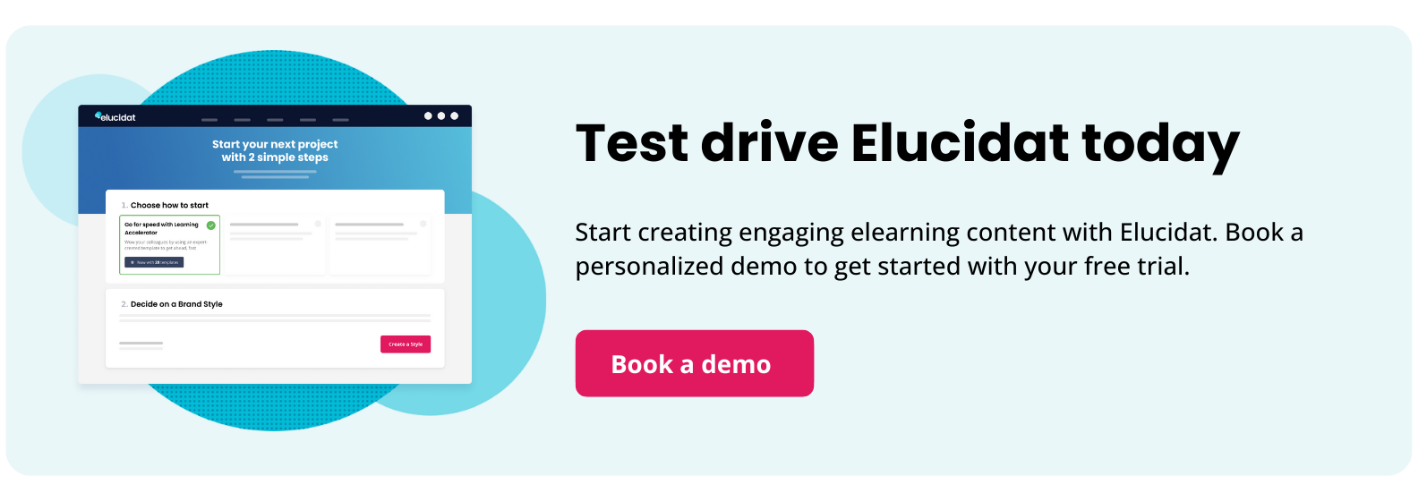How to improve your employee training program in 4 key steps
10 minute read
Employee training is important in so many ways. It helps improve employee engagement and increases employee retention. If done right, a robust training & development plan also has a positive impact on efficiency, innovation and productivity. Naturally, training is good for employees and, ultimately, your profitability and customers.
Creating a good employee training program doesn’t just happen. It needs to be effective. It needs to be modern and fit for purpose – in other words, personalized. This means thinking digital.
If you’re not sure what modern professionals want from their learning, check out this helpful infographic.
To learn how to develop a training program for your employees, read on for our four key steps:
- Establish goals for your training program
- Build an employee training plan
- Create employee training content
- Track and improve – Cultivate your content

What is an employee development plan?
First of all, an employee development plan is essentially an action plan to ensure an individual or team is growing and developing in their role. If you’re developing a training program for your employees, it’s important that the L&D team take ownership of its direction while working alongside the employee in question.
Utilizing a training and development plan is a great way to retain top talent as well as upskilling, or even reskilling, existing employees in line with organizational goals. It differs from a personal development plan, as it focuses in on professional goals as opposed to more broader life goals.
Why create an employee development plan?
Self-development is a big motivator. By creating a skill development plan for employees, the workforce is motivated to achieve their own personal goals which work in tandem with the overarching goals the business is looking to achieve. It’s all well and good beating the drum around targets and kpis that the organization need to hit, but if those who are working towards the goals aren’t taken care of, they could fall on deaf ears.
Employee development plans address this, placing emphasis on the professional goals and growth of each individual in the team. This plays a crucial role in lowering turnover, reducing the costs of training and onboarding external hires in the process.
What makes employee training effective?
Effective training goes beyond simply imparting knowledge, it’s about ensuring that employees can apply their new skills confidently and efficiently. Key elements of effective training include clear learning objectives, interactive and engaging content, and continuous feedback loops. The best training programs are designed to be relevant to employees’ everyday tasks and challenges, ensuring that the training is directly applicable and easy to retain.
Additionally, providing a variety of content formats, like video, quizzes, and hands-on practice, helps cater to different learning styles and keeps employees engaged. When training is tailored, measurable, and aligned with business goals, it’s more likely to lead to positive, long-term results.
How to create an employee development plan
Step 1: Establish goals for your training program
Before you start developing a training program, you need to pinpoint the goals, needs and target audiences. This is a critical step in understanding the gap between what skills your users already have and where more training is required. Are they in need of hard skills like qualifications, or do you need to teach soft skills? It’s not enough to just listen to what senior stakeholders think users need.
Capturing a clear, honest set of needs helps you establish what you will use as a marker of success for your employee training initiatives. It also enables you to prioritize which training objectives need tackling first, which ones will be most appreciated by your employees and which ones will have the biggest impact on your business.
To do so, you need to ask the right questions and create some user profiles. Our free Capture template can help with this.
Step 2: Build an employee training plan
Once you have decided on the wider goals of your training, the next step is to focus on the learning objectives, e.g., what you want your employees to be able to do differently? The best learning outcomes are specific and easily measurable
A few examples may include:
- Handle complex contract renewal negotiations
- Adopt a new framework to set business targets for the next quarter
- Apply a new process for handling customer complaints
Map out your learning objectives as specific sub goals for each module or lesson in your employee training plan. This will help to ensure your content is hyper-targeted and tied to that specific outcome. It also allows you to measure the success of each module, i.e. did the content deliver on its intended outcome? – and if not, evaluate how it can be improved.
This stage is a great time to enlist the help of Subject Matter Experts. Collaborating with a Subject Matter Expert (SME) can help to enrich your content with unique insights. They may also be able to provide advice on how to structure your training plan to ensure the content is delivered in a digestible way, based on their expertise.
Asking a SME to review the content for your training and development plans can help to spot any potential gaps and suggest new modules to include. Utilizing Subject Matter Experts to produce a learning development plan will enable you to produce more frequent content, that’s more authentic, even more personalized and meets demand – for less budget!
Read more about how to foster fruitful relationships with SMEs here.
Some authoring tools are specifically designed to nurture and facilitate effective collaboration between Learning & Development teams and SMEs. Elucidat is a next-generation authoring platform which brings together L&D and SMEs to produce high-quality content, fast.
Don’t forget the importance of engaging your stakeholders in the process. Senior buy-in is critical for getting budget sign off for a content authoring tool that will support your training goals, and for promoting the importance of training and encouraging active participation from employees.
Step 3: Create effective employee learning experiences
The key focus of this step is creating compelling and impactful content and providing an effective learning experience for the end-user.

Choosing an authoring tool
Whether you’re creating your training in-house or via third parties, your choice of software will make a huge difference to the end product and how successfully it performs against the success criteria set out in Step 1.
9 things you should consider when exploring authoring tools for your employee training program:
- Ease of use – what templates are provided and what design support is available?
- Flexibility and control – can you go bespoke if needed?
- Brandability and ability to re-style – what personalisations options are there?
- Collaboration and review features – can multiple team members work together to build the program?
- Mobile-ready and responsive – how accessible is the content?
- Maintainability and ease to re-publish – can you scale your training program?
- Localization features – can you adapt the content for employees in other global regions?
- Analytics and data streams – how easy is it to analyze the performance of the program?
- Publishing options – standalone, SCORM, xAPI?
Above all, make sure that you demo any tool before using it – it’s the fastest, easiest and most accurate way of finding out if an authoring tool meets your needs.
Creating employee training content
When it comes to employee training content, it’s important to remember that there’s no ‘one size fits all’. What works for one audience and requirement won’t necessarily work for the next, so consider each project individually. For that reason, it’s likely that your employee training plan will include multiple formats and activities, such as video explainers, interactive quiz modules and longer form e-book content.
Ultimately, the success of your staff training program relies on your employees engaging with the content, so it’s essential that you consider the context, design, format and delivery method of your program at the planning stage.
- Context: What makes the content relevant and useful? Why should employees engage with it?
- Design: How can you present the information in a digestible, attractive and engaging way?
- Format: Have you incorporated interactive elements or deployed other strategies that can help employees retain new information?
- Delivery: How will you distribute the content to your employees? Will you publish it directly, with its own URL or host it somewhere else?
To ensure your staff training program will resonate with your users, evaluate which training models will provide most value to them.
To help you build an effective training program, we’ve created this simple training design process guide you can implement to start creating engaging elearning.
Timing your training right
It’s important to deliver your training at the most convenient time for your users; training provided too early or too late can be disruptive or worthless to the user. The best time to deliver your employee training program will vary depending on the content and audience, but some examples include:
- Training that is provided on-demand, immediately prior to using a product (e.g, Just-In-Time (JIT))
- Hints or push messages triggered in your software products that point employees to training when the software “senses” that they’re stuck (for example, if the employee is spending a long time on a certain feature or using it incorrectly)
- Employees are either “pulled” to the training (for example, being directed to support pages or training programs) when necessary, or training is “pushed” to them (such as in emails containing hints, tips, or videos) as part of a schedule.
Step 4: Track and improve – Cultivate your content
Learning and development programs aren’t static. The best ones continually evolve and improve. Watching how employees access and interact with your training, as well as evaluating its effectiveness, helps you decide how to make it better.
Consider the following activities:
- Review online quiz results to see if particular questions are consistently answered incorrectly. If they are, maybe the questions are at fault, or maybe the content is inadequate.
- Measure against the success criteria you identified in Step 1 to determine if the training is having the desired effects.
- Monitor those crucial numbers – How many users? What time of day? What device? How long for? Do they come back? – and more, with in-built Analytics.
- Review your support requests to see where training could be created or improved.
- Directly ask employees and managers about their performance pain points and what’s helping/improving.
As well as our Everyday Guide to Analytics linked to above, take a look at our Cultivate guide. This sets out ways to not only measure what’s going on with your elearning, but how to improve upon it. Download the free Cultivate guide now.
Establishing your employee development plan
Creating an employee development plan is just one piece of the puzzle. Having invested time, effort, and resources into its creation, it’s important to put the same amount of energy into making sure your employees get the most out of it.
The best examples of training plans for new employees utilize SMART goals to ensure they’re operating to their full potential. By setting learning and development objectives, managers can set clear deadlines and checkpoints, making it easy to measure the effectiveness of the program.
For full training plan development, codifying is important. Make sure that the training development plan is a formal, working document and not something that can be misconstrued as separate to an employee’s daily work lives. Codify the plan and always refer back to it to establish its importance.
How to improve employee training quality
Improving the quality of your training programs is essential for ensuring that employees gain valuable skills that directly contribute to business success. Here are a few proven strategies on how to improve training quality in your organization:
- Set clear learning objectives: Define specific, measurable goals tied to business outcomes to ensure employees know what they need to learn and why it matters.
- Make training interactive: Engage employees with interactive content like quizzes, scenarios, and discussions to boost retention and real-world application.
- Provide ongoing feedback: Regular assessments and feedback help identify knowledge gaps and keep training relevant and effective.
- Leverage technology: Use tools like Learning Management Systems (LMS) to track progress, personalize learning, and gather insights for continuous improvement.
- Ensure accessibility: Make your training accessible to all employees by offering varied formats and ensuring inclusivity for diverse learning needs.
By implementing these strategies, you can create a more dynamic, effective, and high-quality training program that will not only benefit your employees but also have a measurable impact on your business performance.
In conclusion
There’s much more to implementing a meaningful employee training program than putting a few PDFs on a website. If done well, it can form a crucial part of your corporate training strategy, helping you to hit your business goals, maximize your profits and develop your workforce.
As you’ve seen here, the best way to achieve a good result is to think carefully about what training you’re going to provide, how you’re going to deliver it and how you can evaluate it to make future releases even better. A learning development plan for employees isn’t something that sits still. It needs to be improved upon and developed in its own way.
If you are still not 100% sure which elearning tool is the best choice for your organization and you’d like to review your options, don’t forget to check out our blog on the most popular course authoring tools.





